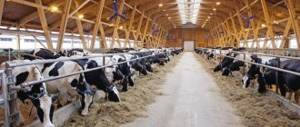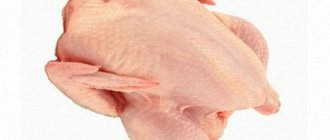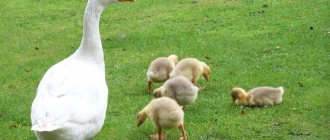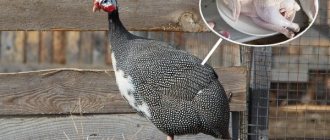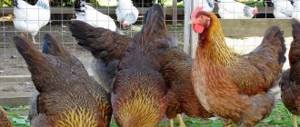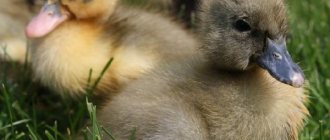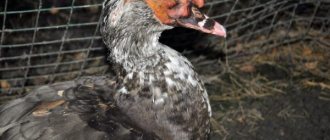Poultry breeding is becoming a promising business due to the increasing demand and consumption of meat and eggs in Russia every year. At the same time, you can also sell fluff, feathers, bones and animal droppings, which guarantees break-even production. If you have a summer house or a private house with a plot of land, to start production it will be enough to purchase an incubator , a minimum of equipment and high-quality parent stock.
Poultry meat is in greatest demand among Russian consumers and accounts for an average of 45% of total sales . The leading position is occupied by chicken meat, followed by turkey meat, whose popularity is growing every year.
The most profitable bird for breeding at home
Having decided to start poultry breeding as a business, you should decide on the type - chickens, geese, ducks, etc. The choice directly depends on the goal that the entrepreneur sets for himself and on the product he is focusing on. Let's take a closer look at who is most profitable to breed at home.
What breed of chickens is the most egg-laying for home breeding?
Chickens were the first birds domesticated by humans about 8 thousand years ago. Ancient people began to breed them, discovering such useful properties as egg production and large body weight. There are many breeds of this bird. If the goal of breeding is to obtain a large number of eggs , then you should pay attention to egg-laying chickens. It is important to purchase good laying hens and a rooster with a ratio of 1 male to 10 females.
When choosing a breed, the following criteria must be taken into account:
- Quantitative egg productivity - at least 280-300 eggs per year;
- Immunity to diseases;
- Quick adaptability to the location of future content;
- Unpretentiousness to living conditions and feed.
, bred in the 19th century, is considered one of the best breeds of laying hens Almost all modern egg breeds are obtained by crossing Leghorn with other chickens. Birds begin laying eggs at the age of 17-20 weeks and are record holders for egg production: about 370 eggs weighing up to 62 grams during the year. At the same time, the survival rate of chickens is high - 92%.
Broiler breeds - which are better
If the purpose of raising chickens is to sell meat, then you should pay attention to broilers, they quickly gain weight. These meat birds are produced by crossing different breeds and are not suitable for breeding, as they lose their properties in subsequent generations. Therefore, it is profitable to purchase new individuals of the first hybrid line from special farms, which fully mature in 70 days and are then ready for sale.
When planning to breed meat breeds, it is worth considering their features:
- The need for a balanced diet and good care;
- Predisposition to certain diseases;
- High risks of death in the first two weeks of life;
- Fattening one chicken will cost 7 kilograms of feed in two months.
Every year, as a result of crossing different species - crosses - new types of broilers arise that are superior in all respects. Among the largest types of crosses are:
- COBB-500 . A distinctive feature is the skin of a bright yellow hue. In 6 weeks, the chickens are fully mature, weigh between 2 and 2.5 kg and are ready for slaughter. The breed is resistant to diseases and has an almost 100% survival rate.
- ROSS-308 . Very fast growth - 50-60 grams per day. It is popular among household owners and farmers because representatives of the species produce quite viable offspring. Broilers reach the required weight of 2.5 kilograms by 7-9 weeks.
- ROSS-708. Leaders in early maturity: after a month the broiler already weighs the required 2.5 kilograms. At the same time, the birds are unpretentious in keeping, and their diet consists of ordinary feed.
Which breeds of ducks are the meatiest and grow fastest?
Ducks are the fastest growing birds with high growth energy. For home breeding, the most suitable breeds of meat ducks are those that can provide their owners not only with meat, but also with eggs, down and feathers. The advantages of raising ducks include:
Growth intensity and early maturity - with high-quality nutrition and proper care, ducklings gain 2 - 2.5 kilograms by the age of two months and are ready for slaughter;
- Omnivorous - no special feeding required;
- Fertility - one duck hatches up to four dozen eggs per year;
- High viability and adaptability to various conditions;
- Excellent taste and nutritional qualities of duck. The meat is rich in iron, B vitamins and high in saturated fat, which have antioxidant properties.
Let's look at the five most profitable duck breeds for the household.
- Bashkir ducks are the most common in our latitudes. They are distinguished by early maturity, resistance to disease, unpretentiousness in maintenance and rapid weight gain. Their tender meat, without a specific taste, is characterized by a small amount of fat and a large yield of muscle tissue.
- Peking ducks are considered the best among meat breeds. Due to their extremely active metabolism, they quickly gain weight. The tender and juicy meat of fifty-day-old ducklings, weighing up to three kilograms at this point, is especially valued.
- Muscovy ducks, or Indian ducks, are the largest meat breed. By three months they reach a weight of up to 5 kilograms. Their meat is considered dietary due to its low fat content. Muscovy ducks are good brood hens; they produce up to 100 eggs per year, which are in demand in cooking.
- Mulards are sterile ducks resulting from crossing Muscovy and other breeds. They occupy one of the leading places in the rate of weight gain - at 3 months they can reach a weight of 6 kilograms, while being distinguished by their economical feed consumption. It is the liver of mulards (and also barbari) that is used to prepare the delicacy foie gras.
- Gray Ukrainian ducks are distinguished by their unpretentiousness in keeping and food: they can feed on duckweed obtained independently from a pond, grass, and mixed feed. They are extremely cold-resistant, gain weight well and lay - up to 260 eggs per year.
Is it profitable to keep geese for sale?
Goose meat is not as popular as chicken or duck, which is due to the complex process of growing them. At the same time, goose meat is rich in vitamins, minerals and amino acids that produce antibodies to fight bacteria and viral infections in our body.
To breed geese you will need:
- The presence of a large area for grazing, preferably with an adjacent body of water. The main costs when breeding geese are associated with the purchase of young individuals and feed, which geese consume in large quantities. With free grazing, geese will consume more green feed or duckweed from the pond and gain weight due to them, which will help save on purchased feed;
- Having your own grain crusher, since it is more profitable to make food for geese yourself;
- It is necessary to immediately get a heavy meat breed of geese, since outbred domestic geese slowly gain weight. And in 3-4 months a purebred bird will gain more than 4 kilograms. At the same time, adult individuals reach a weight of 7-8 kilograms, and males - up to 15;
- Own incubator for breeding goslings for sale. Profit can come not only from meat, but also from the sale of purebred goslings, whose cost is quite high.
- If you have the opportunity to fulfill all the above conditions, then breeding geese can become a profitable business. Otherwise, it's better to use your powers elsewhere.
Is raising quails as a business profitable or not?
One of the main disadvantages of quail breeding is the novelty of the product for the Russian consumer, who considers quail eggs and meat exotic and prefers to buy chicken. But this is the main prospect for business development: other countries are already showing interest in this bird, which means it will soon reach Russia.
A few more undeniable advantages of quail breeding:
- Small starting capital. If you don’t set up a large farm right away, but start with a flock of 500 birds, then even with the purchase of all the necessary equipment you can spend 50,000 rubles;
- Low cost of necessary equipment. And if you make the cages and brooder yourself, you can further reduce costs;
- Fast payback. Occurs approximately from the fifth month after the acquisition of quails. At this time, laying hens achieve stable productivity, and excess males can be sold;
- Easy bird care. A herd of five hundred heads requires up to 4 hours a day to care for, which can be handled by one person without any problems;
- Small area for breeding. Quails are very compact; 20 sq.m. will be enough. with multi-level placement. At the same time, it will be convenient to care for the birds and there will be space for storing food;
- High consumer properties;
- Low level of competition.
Quails are capable of laying eggs 1.5-2 months after hatching, while the bird lays up to 300 eggs per year . The productivity of quails decreases by the year, then the time comes to put them on meat - the weight of one carcass is 200-350 grams. The cost of one egg is 1.5-2 rubles, and the carcass is 60-90 rubles. This way you can roughly calculate the income from your herd. Don't forget to take into account the costs of buying food and lighting.
Is raising turkeys as a business profitable or not?
Turkey farms, which originated in America, have recently become popular in Russia, where raising turkeys at home is gaining momentum. Dietary poultry meat is highly appreciated by Russian consumers. It contains an ideal balance of amino acids and a record content of phosphorus and iron.
Let's figure out what is needed to breed this type of bird:
- A spacious room that needs to be insulated for keeping birds in winter; A large area with grass so that the birds can walk and the turkey poults can browse;
- Special feed containing additives for bone growth and strengthening, vitamins and medicines for disease prevention;
- A separate place for keeping chicks that require special care and attention; The initial investment to start a business is about 200,000 rubles. This includes the purchase of turkey poults, the construction and equipment of a spacious poultry house, feed and veterinarian costs.
What are the benefits of business:
- Turkeys grow quickly and gain weight up to 25 kilograms depending on the breed;
- Year-round demand for meat if sales points are established in advance;
- The profitability of the business is about 90%, and the payback period is a year and a half;
- You can get your first profit within six months: you can sell meat, eggs and raised young animals.
Cattle or sheep: which is more profitable?
Cattle or sheep: which is more profitable? How do you think?
Try sheep first if you are a beginner, then learn more about cattle and make your choice, good luck!
Of course, I don’t want to be deceived. But as for me, even if you are a beginner, it is better to start with cattle. BUT, YOU NEED TO WEIGH ALL THE PROS AND CONS. Is there food, pastures in the summer, where and how will you sell the milk?
Our neighbors keep both at the same time. Sheep readily eat the hay of cattle, they are less picky about feed, both need to graze, the feed is similar, sheep do not need warm rooms, again, with cattle the problem is where to donate and whether to donate milk, what with sheep is the problem with the same wool, where to put it...
But this year we have no problems with milk, even resellers charge 19 rubles per liter. And neighbors pay 80 rubles for 3 liters. Not a bad price in my opinion.
This is where it seems, apparently. We don't seem to accept it at all. The neighbor keeps 10 milk cows, besides this, of course, he has heifers of different ages from them, bulls, so since they don’t accept him, he milks only half, the rest is suckled by the calves, and he is forced to sell half to friends, fortunately there is a demand .
Yes, there is a demand for milk, but there is something not so good about meat.
Animals and plants can always get sick and die. There are only two consolations: people are always hungry and at least you know what you are eating. But on the contrary, the locals don’t have any problems with meat, they take it, at least it smells like meat.
Read also: Raising broiler chickens at home
I have been engaged in private farming for 8 years, I keep both cattle and sheep, but every year the benefits are different.
There is only one benefit - you will be full... and you will not die of hunger... Both are good.
These are completely different directions, everyone’s manure needs to be cleaned, but the sheep need to be sheared twice - to squirm, not to shear - it’s better not to start them.
I don't keep sheep. But in my zoo there is a little bit of everyone: cows, goats, pigs, rabbits, geese, chickens, Indians, quails.
It seems like I haven't forgotten anyone. Every year something goes better, something worse, but eggs and milk are always in demand.
Wow! Almost a zoo! Geese and quail are also in the plans for the near future, but rabbits are still in question. Do you keep large breeds of rabbits or regular ones? Are there any ducks?
I keep all kinds of rabbits. You usually start with “small” forms, then you gain experience, acquire clients and... away we go. There are no ducks.
I recently got into ducks - there is no natural reservoir (they are very voracious).
As my advanced Moscow nieces said after looking at my farm: “What you need, uncle, for complete happiness: a horse, ducks, guinea fowl and... ostriches.” I imagined this picture to myself and thought: “I already have rope and soap.”
Horses are not scary, ducks, it seems to me, are even easier than geese, but the ostrich, a pest, is too big...
I don’t know, we just started with ducks, cross Favorite, it makes sense to keep them for only 2 months, they eat little, up to this age, we grew up on bran, but after 2 months they don’t grow anymore, they get fat and the food is simply wasted it turns out. But they have to lay eggs, but almost all year round, now it’s spring, let’s see what happens, I liked that the ducklings are tenacious, they don’t need heat, in 5 days they were already swimming with all their might.
We want to try geese in the spring.
It’s easier for me with geese; I have a field next door about 15 kilometers long. There is room for my caterpillars to roam.
I started breeding geese with a gosling and two geese, I bought 3-week-old ones, I didn’t even know which one was which... But now there are 42 geese.
Do you have egg quails or the “Pharaoh” type, egg and meat ones? I don't know what to choose.
My quails are Japanese egg quails. Where in Russia are you located? This is important from the point of view of the food supply.
Kurgan region. We are practically urban, about 16 years ago we went to live in the regional center for 2 years, we only kept rabbits and then only for a short time, they were too beautiful and fluffy, like cats, it was a pity to kill them. And then a year and a half ago we left for the village and away we go, we started with a goat that spring, now there are 3 of them, chickens, however, they only give me a headache so far, I don’t know, we don’t lay eggs well, ducks, turkeys, the family has grown, I don’t know what’s next will be with them, and they took a pregnant heifer here in December... It also looks like we are marking a zoo.
It is especially unclear that with chickens, there is already a barn with heating (radiators from the boiler room) and light for them and additives, about 20 of them sitting, and eggs alternately 0-1-2, because according to the schedule.
In my experience, chickens need three things: breed, feeding, and that there are no drafts.
I have three types of chicken: I keep clean egg-laying ones in cages, others - on free grazing, and meat ones next to them, but separately...
There is no draft, feeding is normal. It looks like the breed still needs to be changed. They also began to lean towards the opinion that it is better to keep pedigree animals, otherwise, as they say, there is no fish, no meat, no eggs, no meat.
My husband had a question about where we can get the sizes of cages for chickens , otherwise we simply keep them on the floor in a barn in a pen, perhaps we should still keep ours in cages, at least we will know who is capable of what.
I make cages for chickens according to my size, to fit my chicken coop.
So far, such interesting things are happening here, last year we bought a goat, already with a belly, took it to the Gazelle, and three days later she unexpectedly presented us with 4 kids, and this year they bought a pig, it seems like she might be pregnant.
In general, one fine evening they accidentally noticed her dangling nipples and were surprised, okay, we had time to prepare everything, because that same night she gave birth to us.
And now we have a goat, when she walked (it’s different), we don’t know, she often walked, we took her from the neighbors, they also tried to cover her several times, it didn’t work, and now a year has passed, we see that her belly is growing and her character has changed, Colostrum seems to be appearing, now we are wondering when she will give birth.
We were the first to get lucky with the goat, we bought it by accident, it just happened and it happened, the roads were impassable, we walked from the highway to that village, there were 2 goats - a young one and her mother, and it was sold by the grandfather, who had been in the hospital a month before lay there, and there was no one else to look after, so the old goat came to us on its own, we took her, and the young goat was no step away from her grandfather, like a little dog...
But we saved 2 of the 4 kids, at 3 weeks they suddenly fell ill, became dehydrated and died literally within a day, we didn’t understand anything, we had to inject them with vitamins, apparently, the lack of care and normal feeding had a bad effect during pregnancy...
Read also: What can be grown profitably in the Krasnodar region
Registration of private household plots
If you are planning to raise poultry as a business on a personal or rented plot of land and do not want problems with the state, you should think about registering a personal subsidiary plot (LPH).
Private household plots mean non-entrepreneurial activities for the production and processing of agricultural products. All products manufactured by the owner are considered his property and can be sold. At the same time, only members of one family participate in private household plots. Non-relatives are only included if they live with you.
You can organize private household plots on your own or rented land if you have issued permits. You can keep animals and birds or grow vegetables immediately after obtaining the right to land, without registering private household plots as a legal entity.
Local government bodies are responsible for registering private household plots. Therefore, submit the following information to the administration of the locality to enter data about your private household plot in the household ledger:
- FULL NAME. and date of birth of the owner or tenant of the land plot, information about family members;
- Cadastral number of the plot and its area;
- Number of animals and/or poultry;
- List of agricultural machinery, equipment and vehicles.
After registering a private household plot, develop your business and legally sell your products. To do this, obtain a certificate from the administration stating that the goods were produced in private household plots. In this case, the proceeds are not subject to taxes and VAT, regular payment is only for land tax.
Preparing the room for the incubator and keeping the birds
For comfortable keeping of chickens, it is recommended to have their own premises with an adjacent territory, located away from noise sources. Organize a spacious poultry house so that the chickens do not feel crowded. Divide it into zones: one for laying hens, another for broilers, and a third for chickens. Set up a special walking area. Create comfortable conditions for chickens in the poultry house :
- Good lighting, which helps increase egg production;
- Comfortable temperature is in the range of 10-20 degrees, for chicks - about 30;
- Insulated floor, strewn with straw and sawdust;
- A container of sand or ash to help the chickens keep themselves clean. Clean the room once a week and disinfect it once a month;
- Good ventilation - birds need fresh air;
- Convenient feeders and drinkers, perches and nests
Designate a separate room for the incubator . It should be warm (18-20 degrees), dry and well ventilated. The windows in the room must be darkened to allow the eggs to be visible. Set up a table for ovoscopy, laying eggs in trays and removing hatched young animals.
There are two ways to keep chickens: floor-based and cage-based.
Animal keeping
To obtain meat, bulls are needed. Raising livestock for beginning farmers will involve the question of where the animals will live. Before deciding to purchase young beef stock, you need to decide where it will be located. 1 bull can be placed in a barn, but the building must be insulated and all cracks must be sealed. For a herd of 10 young animals, you will need a barn. It can be built or purchased. Entrepreneurs offer ready-made designs for cattle along with equipment: partitions for stalls, general and individual feeders and drinking bowls.
At first, 1 bull does not require much space. Only 1.5 m2, but it will quickly grow and gain weight. Stalls for young animals should be spacious, at least 2 m2. The total area of the barn is calculated based on the fact that there is at least 11 m2 per 1 bull. For 10 heads it is necessary to prepare a hangar of 110 m2.
Having received the first profit, it will be possible to expand and make a department in the barn to keep dairy calves, for young animals for growing and for the last final fattening, which lasts 3 months. This distribution of livestock will make it possible to rationally use the hangar area.
Along with the bulls, it is recommended to purchase 2-3 dairy cows. They will produce not only milk, but also offspring. You can get a good additional income from cow's milk. Next time you won’t have to spend a lot of money on the number of bulls.
In warm regions, barns are not heated. It is enough to insulate the walls and roof with insulation. The normal temperature in the room should not be lower than +5 C, and higher than +18 C. The air in the hangar should always be fresh. If there is not enough natural ventilation, then an additional ventilation system is installed. Excess ammonia, hydrogen sulfide, and carbon dioxide vapors in the air will negatively affect the health of young animals.
To raise bulls for meat at home, it is recommended to consider beef cattle breeds. They are unpretentious, hardy, have good immunity, and have a high slaughter yield of meat, more than 65%. Consider Simmental animals and Herefords. They acclimatize well, the calves grow quickly and gain weight.
Individuals of the Kazakh white-headed and Aberdeen Angus breeds have unique meat qualities. It is known as marbled beef. Fat is not stored as a separate fat layer. Fat fibers penetrate all muscle tissue.
Before making a decision on cattle breeding, it is necessary to calculate the initial financial investments. Analyze all the calculations to determine whether it is profitable to breed bulls for meat. Along with the arrangement of the barn, it is necessary to provide a walking area. These may be personal or rented pastures.
More on the topic: How to help a cow if she has broken her horn?
To keep young animals in the summer, pens are allocated, which are equipped with a canopy. In the morning the animals will go out to pasture. In hot weather they are kept under a canopy. In winter, young animals are placed in stalls or hangars. When breeding animals for beginners, it is recommended to make some initial calculations.
- To build a barn with an area of 200 m2, you will need approximately 400 thousand rubles.
- Renting a pasture of 120 hectares – 8 thousand rubles. Purchase of a land plot for a cowshed, paddock, area of 1 hectare – 6 thousand rubles.
- For utility expenses - 10 thousand rubles.
- Purchase of livestock – 100 thousand.
- Purchase of equipment – 5 thousand.
- Equipment for a waste pit and a place for dry manure – 10 thousand.
- Hangar for storing feed – 100 thousand.
The farmer will spend 633 thousand rubles on the purchase of young animals and their maintenance, excluding the feed supply. You can reduce costs if you have a large building for keeping young animals and a dry barn for storing feed. Utility costs are taken into account for the year: they will be distributed monthly. This will slightly reduce the financial burden on the farmer. To start, you need to spend about 100 thousand on livestock.
Buying an incubator
For home breeding of birds, purchase special equipment - an incubator - for artificial breeding of chicks . The characteristics and functionality of the device will help your business become successful and profitable.
Which incubator is better to choose?
Before purchasing an incubator, decide on the number of eggs. It is worth loading eggs with a reserve, because some of the eggs will be rejected, and some will turn out to be cockerels.
There are three types of incubators:
- Domestic. Loading from 10 to 280 eggs, compact dimensions. Suitable for a small household.
- Farmer's. Loading from 300 to 500 eggs, automatic systems and multifunctionality.
- Industrial. Loading from 1000 eggs, automated system for large production.
Now let's look at the functions that will help the stable development of the enterprise:
- The automatic mechanism for turning eggs in the incubator will eliminate the need to be near the device and manually move the eggs;
- Electronic thermostat that quickly responds to any temperature fluctuations;
- Plastic or foam material of the device. Polystyrene foam provides thermal insulation, but breaks easily. Plastic is stronger, but needs insulation;
- The power supply to the incubator should not be interrupted, so choose models with a connection to a battery;
- Buy incubators with warranty service, manufactured to strict standards;
- If you plan to breed waterfowl in the future - ducks and geese - choose models with a moisture meter.
Breeding as a village business from scratch
The first place is predicted to be occupied by pig farming. Alas, in Russia there is no more profitable livestock farming area for small rural businesses. Of course, I will seem banal, but to open a profitable village business, it makes sense to start pig farming. It is worth noting that there are two directions (although they can be combined): raising for meat and selling piglets. It is the sale of piglets that is much more profitable, but also more labor-intensive.
- - high payback rate. The normal growth period for a pig to market weight is 6 months.
- - the highest coefficient of meat yield per square meter of area in relation to feed consumption (with normal technology). It’s higher only when breeding rabbits, but they have a whole bunch of their own nuances.
- — stable demand for products
- - high level of manual labor or the need to invest in mechanization
- — the need for initial investments in the construction of premises
- — high feed costs, without the possibility of diversification
The second place is occupied by nutria. By most indicators, growing nutria can be considered one of the most attractive for starting your village business from scratch. You can make cages and pens for them using scrap materials; the animals tolerate cold well, have relatively fast growth, strong immunity, and the presence of both meat (dietary) and skins. Practical experience shows that a family of nutria (3 females and a male) in one year (with offspring) completely pays for the construction of pens, food, and even makes a profit.
- - high yield of meat per square meter of area
- - consume food that can be grown independently, which makes maintenance very cheap
- - don’t get very sick (in relation to rabbits they’re just lively)
- - low costs for premises
- — rather unstable demand for meat. Not everyone is ready to buy nutria meat
Purchasing a parent flock of chickens
In the poultry breeding business, the most important thing is a high-quality parent flock that meets the following requirements:
- High egg production to collect the required batch within a day;
- The correct ratio of females and males is 1 rooster per 10 hens;
- The birds are young and disease-free;
- Compliance with breed parameters;
Poultry nutrition must comply with standards and be balanced in the content of necessary elements. Therefore, take care of vitamins, premixes and other additives in advance:
- Choose industrial feeds carefully, as some may not be suitable. You can reduce costs and make the grain mixture yourself.
- Chickens need calcium, so add chalk, charcoal or salt to their diet to improve digestion.
- You can calculate the amount of feed required for a flock based on the daily norm for one chicken of 130-150 grams.
Feeding the young
Raising bulls for fattening involves 3 stages of fattening. At each stage there is a certain diet.
- Milk period. If you purchase six-month-old animals, then this period can be excluded.
- Fattening up to 10 months. This is a transition from dairy food to an adult diet.
- Growing stage. Fattening of bulls continues until 14-16 months.
- Final period. The diet is designed for 3 months.
Grown bulls are brought to slaughter at 16-19 months. Experts recommend purchasing calves that are more than six months old. They are finishing their milk period. They do not need to be vaccinated because vaccinations are carried out from birth until 6 months. The next preventive measures will take place only after a year.
The purchase is made in the spring, when the first shoots of grass begin to appear on the pasture. Calves can be walked. This is a profitable fattening for bulls. They will gradually get used to the succulent food. This will avoid many diseases associated with the gastrointestinal tract.
It’s warm in spring, so you won’t need a closed hangar. You can equip a barn before winter. During warm weather, calves are kept in open pens. In spring, animals are less susceptible to respiratory diseases. The only thing that needs to be done is to treat them for helminths and insects.
When buying six-month-old bull calves for meat, they prepare a feed base. It should consist of succulent feed, hay, straw, vegetables, concentrates, and fertilizing with minerals. For young animals, a diet for growing is prescribed. In summer, animals eat grass and concentrates. The grain mixture for calves is steamed and given in a semi-liquid state. In order for the scar tissue of the stomach to form correctly, animals need silage and hay.
| № | Helpful information |
| 1 | Green grass - on poor pasture, with 6 hours of walking. This will amount to approximately 6 kg per calf |
| 2 | Hay – 2 kg. Gradually the amount is increased to 4 kg. In just 4 months – 240 kg. This will cost the farmer 100 rubles |
| 3 | Silage – 8 kg per calf. For 4 months – 960 kg |
| 4 | Root vegetables – 4-6 kg. Total – 720 kg. Required: RUB 5,760 |
| 5 | Concentrates – 2-3 kg. Total – 360 kg. Feed costs - 3600 rubles |
| 6 | A growing calf requires minerals, so the diet includes 50 g of salt, 60 g of chalk |
| 7 | In total, during the summer period you will need 10,780 rubles for 1 calf. For 10 heads – 107,800 rubles. Your own vegetable garden can help reduce costs |
More on the topic: Is it necessary to treat the corpus luteum in a cow?
From the age of 10 months, animals raised for meat are kept in stalls. This will increase the daily gain of live weight. Walking periods are reduced to 4 hours. Before walking, calves are fed silage or hay so that they do not overeat the succulent grass. Their diet changes a little. Lush grass is replaced with haylage. It is prepared in advance. Fattening is carried out for up to 16 months. If a farmer is breeding 10 bulls, then he will spend approximately 161,700 rubles on feed.
Up to 10 months, calves will gain weight up to 1100 g. At stall housing 1400 g. Feeding is carried out 4 times a day. If the feeding regime is followed, the young animals will gain weight better. At 10 months the bull will weigh 500 kg.
After the fattening period, the last months of raising bulls for fattening begin. The period lasts 3 months. For fattening, a certain method is chosen, referring to the feed supply that is available to the farmer.
- If there is a lot of silage left, then use the silage fattening method. This food is the main one. It is given 30 kg. For 1 ton you will have to pay 1300 rubles. A total of 35.1 thousand will be spent on silage.
- Hay and straw give the same amount, 3 kg each. Cost 1800 rub.
- Concentrates – 1.9 kg. 17,100 thousand
- Salt – 35 g.
For the last period of raising bulls for meat at home, 54 thousand will be required. If the calf weighed 500 kg, then after supplementary feeding its weight can reach 728 kg. The output will be 473.2 kg. A farmer can get 4,732 kg of beef from the animals raised. Farmers on forums discuss how to quickly raise a bull with minimal cost. The advice given varies. It is recommended to purchase a one-year-old animal and put it on fattening for 3 months.
Sales of products
Let's consider several options for selling chicken meat and eggs:
- Sales of products to shops and supermarkets. Large orders will bring more profit to the household;
- Own point of sale. Open a point at the food market or offer products to other private traders;
- Supplies to HoReCa establishments. Restaurants will willingly purchase natural and high-quality products at an affordable price;
- Sales to private individuals in neighboring communities. Organize a specially equipped car that will come to the city on certain days;
- Advertisements on poles, in social networks, on sites like Avito; Participation in trade fairs where you can find retail and wholesale buyers.
Minuses
The answer to the question of whether farming is profitable depends on many factors, including how the following aspects are analyzed:
- Risks. It is impossible to predict everything. Therefore, it is not always possible to calculate the benefits in advance, analyze the market, identify the main mistakes of colleagues and competitors, take into account epidemics and animal diseases, quarantines and natural disasters, harmful insects, etc.
- Sales market. Creating quality products is not the final goal of this business. It is important to find favorable conditions for selling the finished product. Farming businesses often collapse due to the lack of promising sales channels and the desire of wholesalers to purchase agricultural products for next to nothing.
- Selecting a sphere. What exactly you do depends on where you live and your ability to immediately sell finished products. Production in remote areas involves distribution of goods through intermediaries, which is less profitable at the beginning of starting a business. It is much more effective to enter into direct contracts for supply to supermarkets and stores. But even here it is impossible to calculate the advantages of one or another solution.
Farming businesses often collapse due to the lack of promising sales channels and the desire of wholesalers to purchase agricultural products for next to nothing.
How much do you need to invest at the start?
Initial costs vary from 400 thousand to 1.5 million rubles, depending on the initial herd size , rental premises and other factors. Let's look at the main expense items:
- Purchase of young animals. A laying hen will cost 80-250 rubles, a broiler - 120-210 rubles;
- Business registration. Registration of private household plots is free, but you will have to spend money on an agreement on veterinary services, permission from the SES and Fire Supervision, a conclusion from Rospotrebnadzor, etc.;
- Creation and equipment of a chicken coop on your own land plot or repair and preparation of rented premises;
- Purchase of equipment and inventory;
- Feed for the herd;
- Salaries to employees, if you plan to hire;
- Various additional costs.
